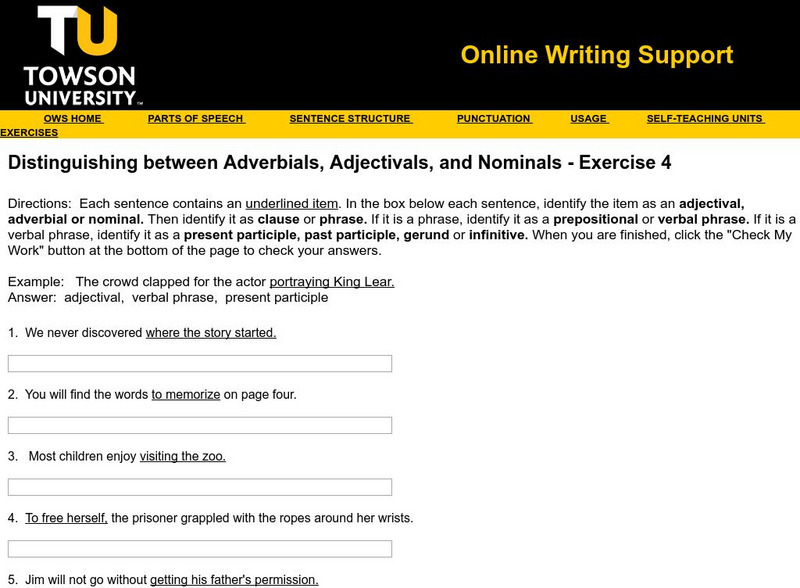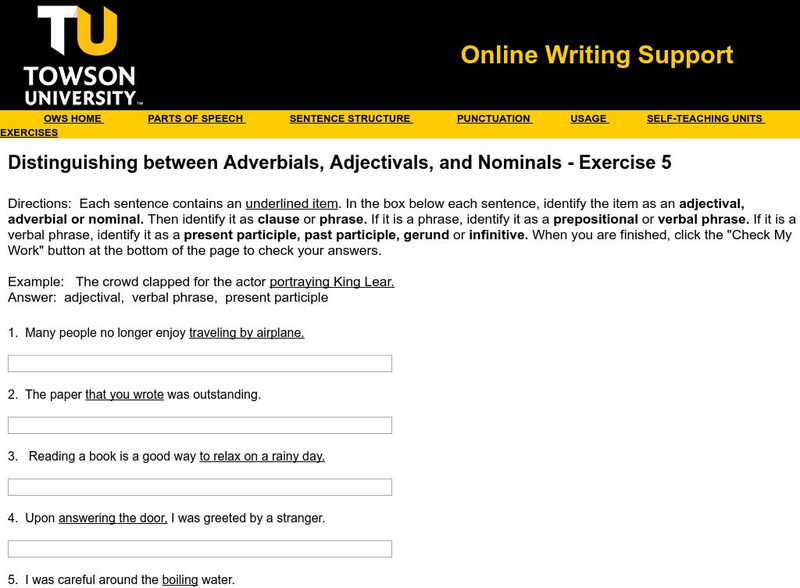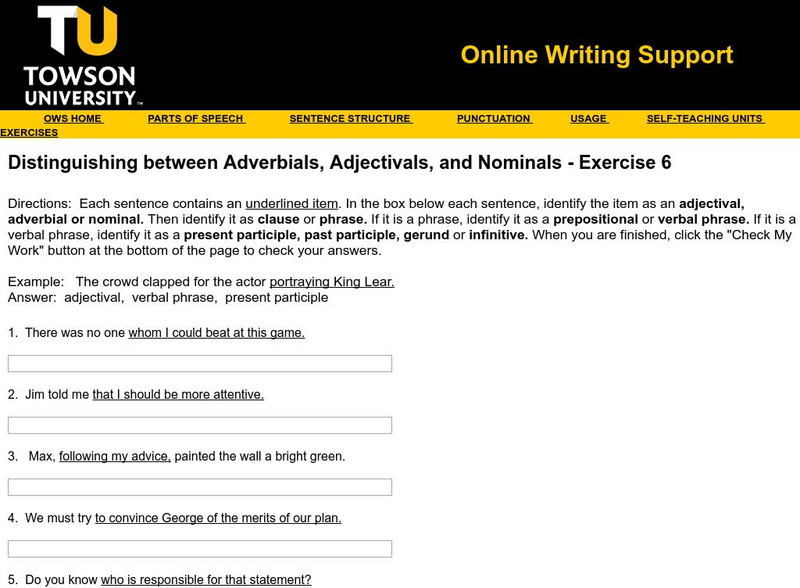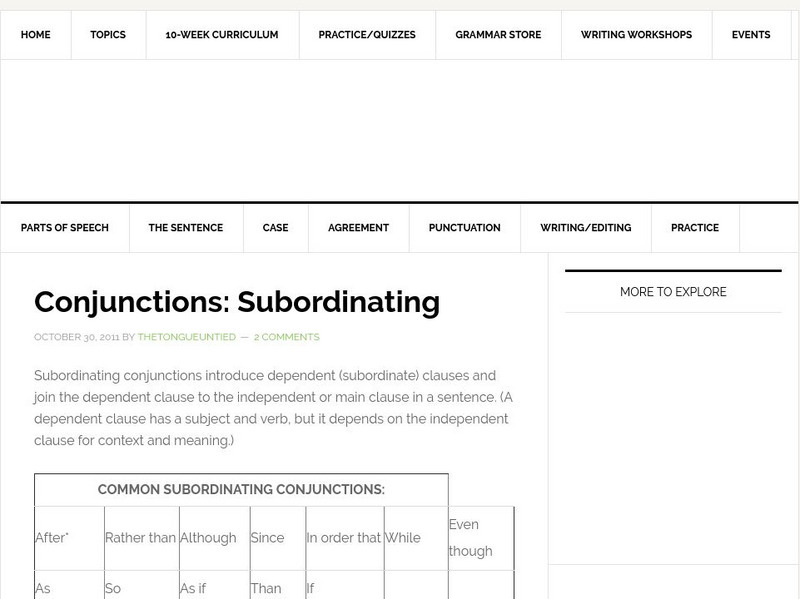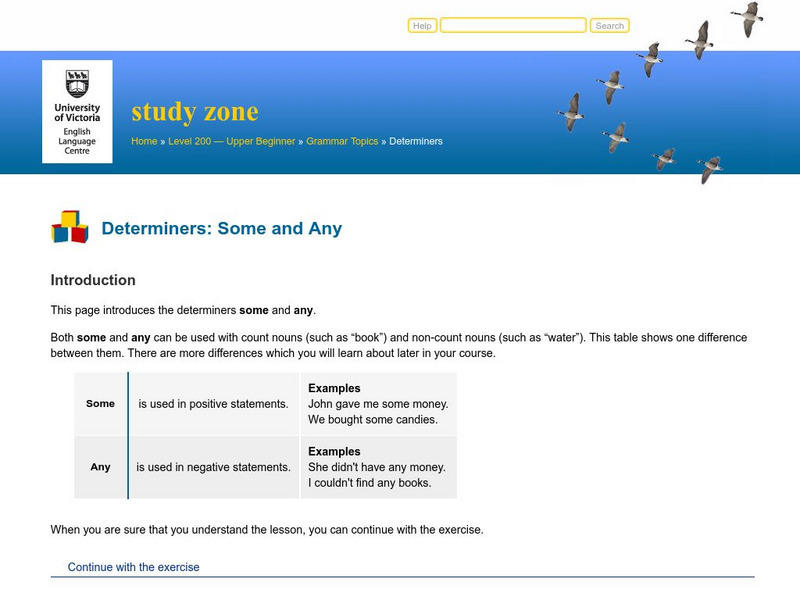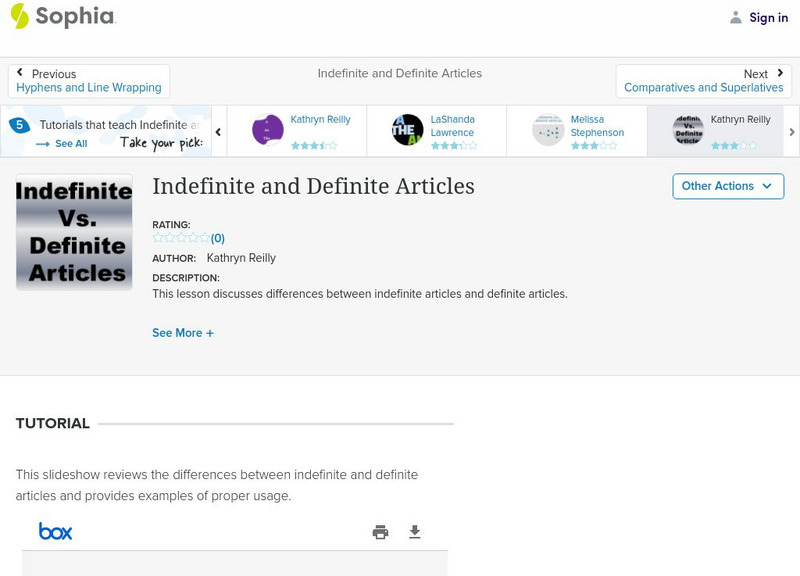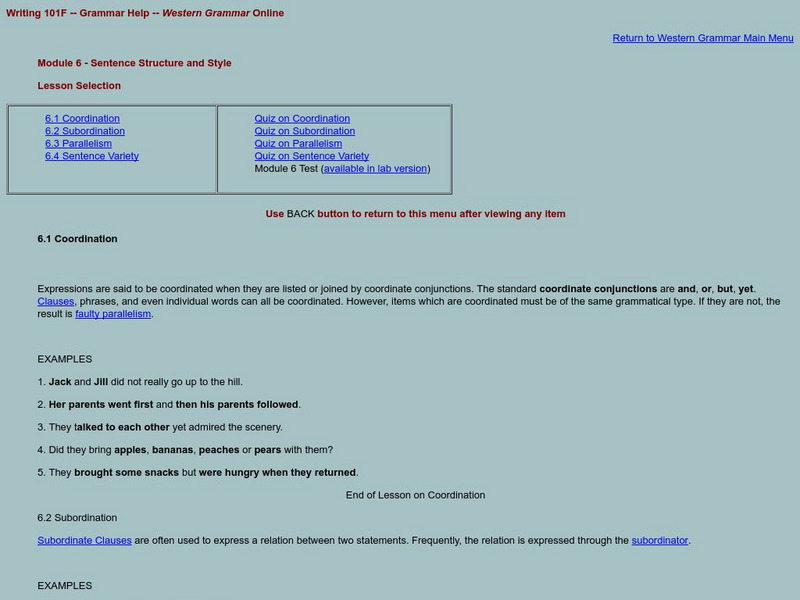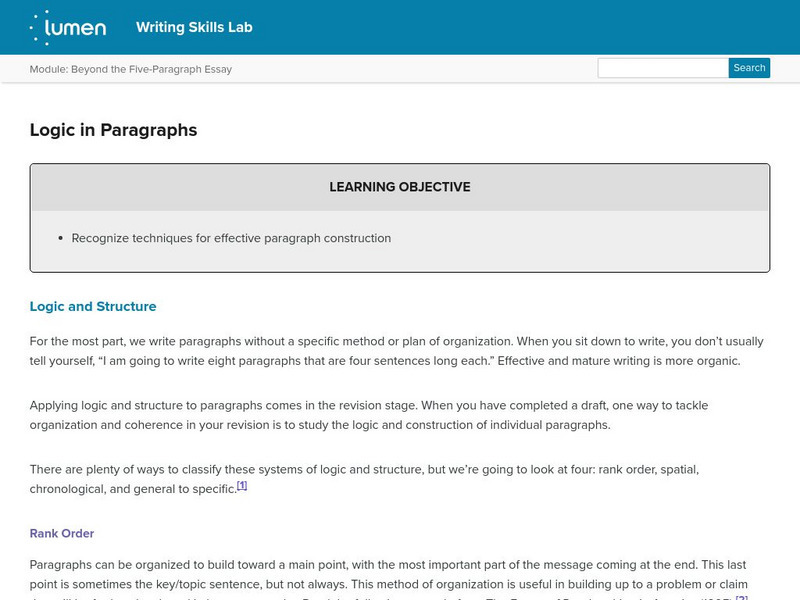Towson University
Towson University: Distinguishing Adverbials, Adjectivals, Nominals Exercise 4
This is a 20-question, self-grading quiz/exercise on Distinguishing between Adverbials, Adjectivals, and Nominals.
Towson University
Towson University: Distinguishing Adverbials, Adjectivals, Nominals Exercise 5
This is a 20-question, self-grading quiz/exercise on Distinguishing between Adverbials, Adjectivals, and Nominals.
Towson University
Towson University: Distinguishing Adverbials, Adjectivals, Nominals Exercise 6
This is a 20-question, self-grading quiz/exercise on Distinguishing between Adverbials, Adjectivals, and Nominals.
Philosophy Pages
Philosophy Pages: Categorical Syllogisms
Provides a detailed look at syllogisms. Sections include the following: "The Structure of Syllogism," "Standard Form," "Form and Validity," and "Diagramming Syllogisms."
Other
Critical Reading: Subject and Predicate
Part of a larger site on "The Fundamentals of Critical Reading and Effective Writing," this section on the simple sentence focuses on the subject and the predicate. Definitions and examples are provided along with a section on...
Other
Colgate University: Clauses, Conjunctions, and Punctuation
This grammar tutorial explains constructing sentences using independent and dependent clauses with correct punctuation.
Other
Cayuga Community College: Clauses, Phrases, and Commas [Pdf]
Learn about phrases, dependent and independent clauses, and how to use commas appropriately with clauses and phrases.
University of Victoria (Canada)
The U Vic Writer's Guide: Grammar: Clauses
This site discusses the two main types of clauses. Content includes instructions for and examples of using clauses to build different types of sentences and information on recognizing types of clauses.
Other
Style: Cause and Effect Writing
This site provides a list of what to do and not do for writing cause and effect essays. It also contains an evaluation checklist at the end which students can use for their own writing.
The Tongue Untied
The Tongue Untied: Subordinating Conjunctions
Maintained by the University of Oregon School of Journalism and Communications, this site offers a standard definition and numerous examples of subordinating conjunctions, using journalistic (newspaper-like) examples. Provides list of...
University of Victoria (Canada)
Univ. Of Victoria: Some and Any: Indefinte Articles
This page contains a brief explanation of the use of the determiners "some" and "any" followed by a fill-in exercise. The exercise is self-correcting but can be discussed between teacher and student to expand the scope of the application.
Grammarly
Grammarly Blog: Qualifiers and Quantifiers
An explanation and examples of how qualifiers and quantifiers are used in sentences. Links to additional information are provided.
Grammarly
Grammarly Blog: Linking Verbs
An explanation and examples of linking verbs and how they are used correctly in sentences.
University of Toronto (Canada)
University of Toronto: Subject Verb Agreement
Site provides some different rules applying to subject-verb agreement, especially in cases of "expressions of quantity." Excellent information for students looking to hone their craft of writing.
Sophia Learning
Sophia: Indefinite and Definite Articles
This lesson focuses on articles; it defines definite and indefinite articles and provides examples of each. It explains the a vs. an rule and the exceptions to the rule.
Capital Community College Foundation
Guide to Grammar and Writing: Parallel Form
This site from the Capital Community College defines the term and gives many examples of faulty parallelism and the corrected version of sentences. Includes links to a couple of quizzes at the bottom of the page. "Most of the...
Capital Community College Foundation
Guide to Grammar and Writing: Clauses: The Essential Building Blocks
Online PowerPoint writing tutorial on the subject of clauses in sentences. L.9-10.1b Phrases/Clauses
University of Ottawa (Canada)
University of Ottawa: Writing Paragraphs
This site from the University of Ottawa provides a wonderfully designed website that not only gives you exhaustive information on paragraph writing. Students will engage in starting with outlines, writing topic sentences, dividing their...
Indiana University
Indiana University: Writing Services: Incorporating Evidence Into Your Essay
This handout explores how to effectively incorporate evidence to support your claims into your paper. It provides weak and strong examples to show effective ways to incorporate evidence clearly and cohesively. W.9-10.1c...
Capital Community College Foundation
Guide to Grammar and Writing: Transitions Between Ideas
This tutorial teaches writing students how to share convincing in well-written sentences that are connected from one to the other--that is, they exhibit transition. W.9-10.1c cohesion/clarity/reason, W.9-10.2c cohesion/clarity/trans
Sophia Learning
Sophia: Concluding Transition Words
A screencast lesson [2 mins, 32 secs] introducing transition words used to conclude an idea and providing examples of how to use such transitions in concluding sentences. W.11-12.1c Transitions/Cohesion CCSS.ELA-Literacy.WHST.6-8.2.c
University of Ottawa (Canada)
University of Ottawa: Parts of the Sentence
This University of Ottawa site overviews the parts of the sentence and then provides a list of links to the various individual parts including subject and predicate, objects and complements, noun, pronoun, phrase, clause, and a review...
Other
Instruct Uwo: Module 6 Sentence Structure and Style
This site discusses several characteristics of writing: coordination, subordination, parallelism, and sentence variety. Each section includes a brief discussion with examples. There are also quizzes and additional links for each section.
Lumen Learning
Lumen: Writing Skills: Logic in Paragraphs
This lesson focuses on logic in paragraphs including logic, structure, rank order, and organization.


